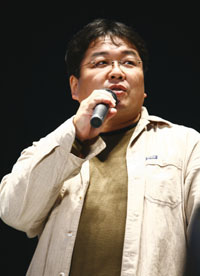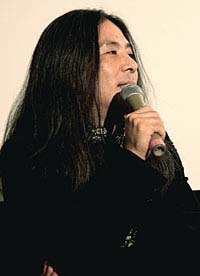Junichi Fujisaku & Chiaki J. Konaka double interview (1)
Real Drive and Ghost Hound are both based on Shirow Masamune's story concepts, but in order to be adapted into full TV series, they obviously needed the work of experienced screenwriters.
In this four-part interview series, we talked with Junichi Fujisaku and Chiaki J. Konaka, series composers for Real Drive and Ghost Hound respectively, and asked about their different approach to Shirow's world, anime storytelling, character development and even voice recording sessions!
 | Junichi Fujisaku - Born on August 6, 1967. Director, scriptwriter, game designer and novelist. He joined Production I.G as Game Production Department Chief Director, but soon became one of Team Oshii's core members, participating to the creation of the theatrical feature Blood: The Last Vampire (2000). The girl in sailor suit fighting monsters with a Japanese sword was in fact Fujisaku's idea. For the Blood franchise he also directed the game version and wrote the novelization. Fujisaku also gave his valuable contribution to the expansion of the Ghost in the Shell world, writing the scripts for many episodes of the Stand Alone Complex series, producing and directing the game version for PS2, and writing three related novels. In 2005 he debuted as a TV series director with Blood+. Besides Real Drive, he's now writing the scripts for the FX live action TV series Phone Braver 7, directed by Takashi Miike. |
 | Chiaki J. Konaka - Born in Tokyo on April 4, 1961. Scriptwriter and novelist. His most famous works include The Big O (series composition and scripwriter, 1999) , Serial Experiments Lain (series composition and scripwriter, 1998), Hellsing (series composition and scripwriter, 2001), RahXhefon (scripwriter, 2002), Texhnolyze (series composition and scripwriter, 2003), and Kino's Journey: The Beautiful World - The Land of Sickness -For You- (screenplay, 2007). Other from animation, he also wrote scripts for the SFX series Ultraman Tiga (directed by his brother Kazuya) and for Takashi Shimizu's acclaimed J-horror movie Marebito (2004), based on his own novel. A renown H.P. Lovercraft estimator, Konaka is also a bass player in the band #3b3 Orchestra. |
Part 1: Story and Characters
Both Ghost Hound and Real Drive are based on an original concept by Shirow Masamune, but I heard that you had the liberty to some extent to do whatever you wanted to do. Could you talk first about how you started and worked on your projects?
Konaka: Director Ryutaro Nakamura and I cooperate in an unusual way. First we meet and chat about various topics and then he would let me do the storymaking on my own. So I rarely consult him about the story.
In Shirow-san's original plot, when the souls of the three boys slip away from their bodies, their head-body ratio changes to 1 - 1 and they converge into a werewolf-like creature. Shirow-san's story also focused on the construction of a dam that causes environmental damages and eventually compromises the balance between the world of the ghosts and the real world. This element was used to convey the main theme of the story, or how much the contact between nature and man gradually changes the world we live in. Taking these into account, I decided to use the werewolf without the transformation, and I added an intense biotechnology flavour to the "dam" element, in order to update the story to the present day. Finally, Nakamura-san made clear that he didn't want a story of boys saving the world. This made thing a bit difficult for me, but it was nonetheless fun to tell the story from the boys' viewpoints.

The theme of biotechnology is hidden in the story in bits. For example, in the first episode, Dai Nippon Bioindustrys plant is already mentioned in a conversation. For your information, I didn't clearly state this in the story, but I intended Dai Nippon Bioindustry to be a part of the giant conglomerate Dai Nippon Technical Research Institute Group. "Dai Nippon Technical Research Institute" is a Japanese company in Shirow Masamune's Ghost in the Shell and Appleseed. This idea was not in the original story, but since the story as a whole deviated greatly from the typical vision of Shirow-san, I thought I could do something to move it back closer.
I also added little pieces here and there, so that those who watched S.A.C. would find them interesting. It is intended for those who would understand. You will find the ancestor of the Tachikomas, for example. (lol) I hope the viewers will roughly see its connection with the world of Ghost in the Shell. Although, to be exact, in Ghost in the Shell, the outbreak of WWIII was in 1996, so Ghost Hound has to be a story of a parallel world.
Anyway, I wouldn't want people to think that I took complete liberty and deviated from Shirow-san's world, so I'd like to make a point here that I have followed the original plot of Shirow-san. (lol)
Talking about taking over Shirow's world, I heard Fujisaku-san initially created a new "post-Ghost in the Shell" World.
Fujisaku: Yes, we started with the idea, but a request from Director Kazuhiro Furuhashi changed that totally. He said he wanted to focus the camera on people and tell the story of their lives and their realities. Adding to that, he said if he were to direct a Sci-Fi series, he wanted to do it on the theme of "water" which was his dream for a long time. So I had a difficult time connecting those requests with Shirow-san's world. I couldn't come up with a good idea until I coincidentally remembered that both the manga and Director Oshii's movie versions of Ghost in the Shell had used the word, "sea of information." I decide to start from there. Since in this anime I had been asked to visually render a cyber-space, I literally transposed that concept into a "cyber-sea" - to some extent, rather a simple deduction. I also took advance of the widespread use of the word "diving" in science fiction, so at the end I succeeded in comfortably associating "water" and "information."

Then I created two main characters. Masamichi Haru is a diver who instinctively knows how to dive in the "sea" - both kinds of sea - and Eiichiro Kushima, who has been his colleague in research. And to add a real human drama to the story, I introduced Minamo, a fifteen-year-old girl, as a non-regular cast member. You see, Haru is an old man aged 81. The director said he wanted to see the conclusion of their relationship. For this project, I went ahead and created the characters without thinking about the storyline.
Can you tell us more about the main characters?
Fujisaku: We obviously had Shirow-san's original plot, but we virtually recreated it from scratch, so we were able to construct the main characters, as we felt necessary. In this sense, we didn't have to invent particularly unique characters, and everything was developed very naturally and smoothly.
Konaka: In my case too, since I was allowed enough freedom to develop an original story, I used my own method. I usually don't like to "set up" the characters in detail - like personalities and all those meticulous information you might find in a resume - right from the beginning. I would start by wondering about the storyline and imagine its consequences or think about how I could write the story proactively. With these in my head, I go on to write up tentatively. I would say the characters are gradually formed in this process.
(1 - to be continued)
© 2007 Production I.G · Shirow Masamune / GHOST HOUND Production Committee
© Production I.G/Shirow Masamune
© 2008 DNDP, VAP, Production I.G

![WORK LIST[DETAILS]](/contents/works/design/images/left_title.gif)



 terms of use
terms of use